This profile of Redruth WMA has been compiled by Jo Lewis and Tony Mansell.
First Wesleyan Methodist Association Chapel
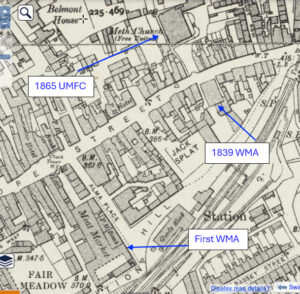 A larger map of the WMA / UMFC
A larger map of the WMA / UMFC
The Wesleyan Methodist Association came to Redruth early with meetings in the new Buttermarket, Station Hill.
The Wesleyan Association was one of the smaller branches of Methodism and resulted from the Warrenite controversy of 1834-35.
1823: Sir Francis Basset had bought the site of Redruth market and its buildings and rights from James Buller for £1,000.
1825: Sir Francis Basset initiated the construction of new market buildings at the south end of the site. The new market occupied a L-shaped footprint, comprising a two-storey market house to the south-east on what is now Station Hill, with a narrow alleyway flanked by single-storey colonnades leading north through a gated entrance to Fore Street, and predominantly occupied by butcher’s stalls. The upper floor of the market house was used for meetings and the Wesleyan Association held services there in 1838.
The 1851 return notes the Wesleyan Association, Redruth, 1838, with 840 sittings (likely to have been the Chapel as below) with Thomas Ellery as minister.
1839 Wesleyan Methodist Association Chapel.
1839: The first Chapel was built in on Fore Street as a Wesleyan Methodist Association chapel.
Heritage Gateway: Built in 1839 as a Wesleyan Methodist Association chapel, later used by the United Free Methodist until a replacement was built across the road in 1865 (b1). Now in commercial use.https://www.heritagegateway.org.uk/Gateway/Results_Single.aspx?uid=MCO33137&resourceID=1020
1839: Opening of new chapel. (Patriot – Thursday 21 November 1839)
1847 documents recite a lease dated 25 March 1839 by Lord Clinton to Elisha Morcom in trust, for dwelling houses on the south side of the street leading to Truro (presumably Fore Street) which have subsequently been taken down and a Wesleyan chapel built on the site. (https://kresenkernow.org/SOAP/detail/9bfa93bb-86f2-49ac-ac33-cd3eeab2ee84/?tH=%5B%22Redruth%22%2C%22wesleyan%22%2C%22methodist%22%2C%22association%22%5D).
1850: Circuit plans exist.
1857: The Wesleyan Methodist Association and the Wesleyan Reform Church amalgamated to become the United Methodist Free Churches.
1857: The Wesleyan Methodists joined with the Wesleyan Reformers (the Redruth branch were meeting in the town hall *** in 1850, to form the United Methodist Free Church.
*** See https://cornishstory.com/2021/06/07/mapping-methodism-redruth-wesleyan-reform/
1865: When the second chapel was built, this building was sold and became a glass and china warehouse before becoming the well-known Jim’s Cash and Carry. It has sadly lost its original frontage but it can be recognised as the chapel from front and side views.
https://historicengland.org.uk/listing/the-list/list-entry/1475141?section=official-list-entry
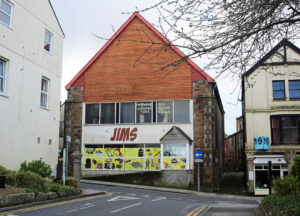 2024 Photo (Jo Lewis)
2024 Photo (Jo Lewis)
 2024 Rear View Photo (Jo Lewis)
2024 Rear View Photo (Jo Lewis)
1865 United Methodist Free Church
1865: Built almost opposite its predecessor – on the other side of Fore Street.
Built as a United Methodist Free Church in 1863, opening in March 1865. (SWCHURCHES)
Records exist from 1863.
This was one of the finest Methodist chapels in Cornwall, built in the Italianate style by T Simpson of Nottingham and affectionately known as the “Flower Pot Chapel” on account of the vase finials that surmounted the parapet. It had a rendered front of five bays with a giant order of Corinthian columns and pilasters and a balustraded parapet surmounted by urns. A review of Cornwall in 1872 described it as a ‘very handsome” building, said to be the “finest dissenting place of worship in the west in the Lombardo Venetian style, the front is richly ornamented in plaster, the interior really elegantly fitted up to correspond, and 1,600 (some references 2000) persons may here be comfortably seated
HeritageGateway: Large United Free Methodist chapel, built in 1865 and demolished following a fire in 1973. Mapped using 2nd edition OS mapping.
A society of the Wesleyan Methodist Association had built a chapel on the south side of Fore Street in 1839, but this was replaced by a larger church on the north side of Fore Street in 1865.
This was one of the finest Methodist chapels in Cornwall, built in the Italianate style by T Simpson of Nottingham and affectionately known as the “Flower Pot Chapel” on account of the vase finials that surmounted the parapet. It had a rendered front of five bays with a giant order of Corinthian columns and pilasters and a balustraded parapet surmounted by urns. All that remains now are two granite gate-piers that stand at the entrance to the car park that contains the site of the former chapel.
The decorative urns from its roof now adorn the gateposts of Victoria Park (1).https://www.heritagegateway.org.uk/Gateway/Results_Single.aspx?uid=MCO33138&resourceID=1020
1865: Opening of new chapel. (West Briton and Cornwall Advertiser – Friday 17 March 1865)
1865: Opening services. (West Briton and Cornwall Advertiser – Friday 31 March 1865)
1907: The Methodist New Connexion, Bible Christians and United Methodist Free Churches amalgamated to become the United Methodist Church.
1907: Became Fore Street United Methodist Church. (SWChurches)
1932: The Wesleyan, Primitive Methodist and the United Methodist Church amalgamated to become the Methodist Church of Great Britain.
1932: Became Fore Street Methodist Church.
1940: Seating for 1560. (Revd David Easton)
1968: Closed. (Revd David Easton)
1973: Camborne-Redruth Urban District Council bought the vacant chapel. (West Briton and Cornwall Advertiser – Thursday 17 May 1973)
3rd June 1973: Destroyed by fire and subsequently demolished. All that remains now are two granite gate-piers that stand at the entrance to the car park that contains the site of the former chapel (as picture).
1973: Flower Pot Blaze still a mystery. (West Briton and Cornwall Advertiser – Thursday 07 June 1973)
1973: Workers find bottle found under chapel foundation stone. (West Briton and Cornwall Advertiser – Thursday 27 December 1973)
1999: A Yesteryear report on the 1973 fire. (West Briton and Cornwall Advertiser – Thursday 04 March 1999)
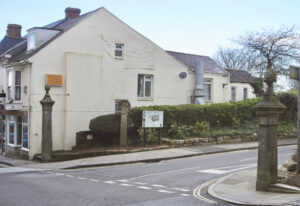 2024 The two granite entrance gate piers (Jo Lewis)
2024 The two granite entrance gate piers (Jo Lewis)
David Thomas commentary
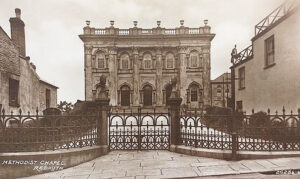 Fore Street United Methodist Free Church, dating from the 1930s. This scene is so changed today as this is the drive-in entrance to the Flower Pot car park. The building was constructed in 1865 and destroyed by fire in 1973. Note the fine cast iron entrance gates and railings, the two side posts of which are still in situ today. The chapel has a commanding presence, while just to its right can be glimpsed the large Sunday School building attached to the chapel which was not so frequently photographed. We will never see the like of these structures again in Cornwall. A total legend of a building!
Fore Street United Methodist Free Church, dating from the 1930s. This scene is so changed today as this is the drive-in entrance to the Flower Pot car park. The building was constructed in 1865 and destroyed by fire in 1973. Note the fine cast iron entrance gates and railings, the two side posts of which are still in situ today. The chapel has a commanding presence, while just to its right can be glimpsed the large Sunday School building attached to the chapel which was not so frequently photographed. We will never see the like of these structures again in Cornwall. A total legend of a building!
It was constructed in the Lombardo Venetian style and was affectionately known as the ‘Flower Pot’ chapel after the large decorative urns that adorned the facade. The building was destroyed, after closure, by a monumental and cataclysmic fire which occurred in 1973, which many will recall. The flames were seen all over West Cornwall for many miles.
This Society’s origins can however be traced back to the late 1830s and a Wesleyan Association chapel that was built in 1838 on the southern side of Fore Street and which still stands today. Local residents will remember it as Grigg’s ironmongers shop. This was then the first Free Methodist chapel in Redruth, replaced by the new building in 1865.
 The picture is a wonderful postcard photo by Redruth photographer H Darlow Wootton, postmarked 3 September 1907. It gives a very good idea of the vastness of this building, generally regarded as one of the finest Nonconformist places of worship in the western parts of Britain. It was Cornwall’s second largest chapel in seating capacity, when constructed, with 1560 sittings (outdoing the rival Redruth Wesleyan chapel), second only to the huge Wesleyan chapel at St Just in Penwith, built 32 years earlier in 1833, which, before alterations in the 1860s, could accommodate some 1760 persons. The white painted organ and rostrum predominate while the round topped woodwork at the southern end of the gallery at the bottom of the picture betokens the presence of the chapel clock, a visual reminder of time, right opposite the preacher!
The picture is a wonderful postcard photo by Redruth photographer H Darlow Wootton, postmarked 3 September 1907. It gives a very good idea of the vastness of this building, generally regarded as one of the finest Nonconformist places of worship in the western parts of Britain. It was Cornwall’s second largest chapel in seating capacity, when constructed, with 1560 sittings (outdoing the rival Redruth Wesleyan chapel), second only to the huge Wesleyan chapel at St Just in Penwith, built 32 years earlier in 1833, which, before alterations in the 1860s, could accommodate some 1760 persons. The white painted organ and rostrum predominate while the round topped woodwork at the southern end of the gallery at the bottom of the picture betokens the presence of the chapel clock, a visual reminder of time, right opposite the preacher!
This chapel has a remarkable archive at Kresen Kernow and was renowned for its musical tradition and many groups and weekday social activities.
The chapel’s name today is recalled by the ‘Flower Pot’ car park as well as some of its surviving facade urns at the entrances of the Victoria Park. It truly was an elegant building with a remarkable history. Many local families were strong adherents here, including the Trounsons, who had a flour merchants business in Fore Street. Many local tradesmen supported this chapel and it had a very well supported Sunday School, founded in 1838.
This was Kernow’s Free Methodist ‘Cathedral’.
Further reading:
https://kresenkernow.org/SOAP/detail/8ccb1379-de93-42aa-a9b8-413d8db9fcaf/?tH=%5B%22flowerpot%22%5D
https://kresenkernow.org/SOAP/detail/75bc78e2-4658-40a1-be6b-7de3781a181f/?tH=%5B%22flowerpot%22%5D
https://kresenkernow.org/SOAP/search/RelatedNameCode.keyword/CRO%7CUK%7C502/

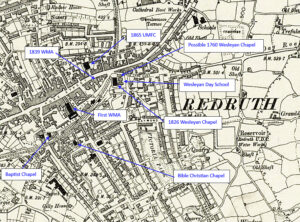 Map:
Map: